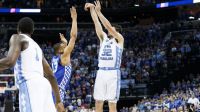College sports are allegedly built upon a foundation of amateurism. Corrine from “The Bachelor” probably loves this idealized vision of college sports, where players are there “for the right reason:” the love of the game, not the money.
But while the players may not be there for the money, everyone else is. Take, for example, the NCAA Men’s Basketball Tournament.
CBS and Turner Sports paid an estimated $10 billion in 2016 for the rights to broadcast March Madness. The head coaches for the Final Four teams – Dana Altmann at Oregon, Mark Few at Gonzaga, Frank Martin at South Carolina and Roy Williams at North Carolina – make over $5.7 million combined. This has been an oft-repeated point, but the salaries of the athletes – you know, both the labor and the product – come out to zero dollars and zero cents.
“They get a free education and housing and food and perks!” you cry, as you do every time you hear this argument.
“What is that even worth in today’s economy?” I yell back, sick of it.
While CNBC is reporting that the job market for recent college graduates is much better than it has been in recent years in terms of employment, it also reports, according to the National Association of Colleges and Employers, that 39 percent of 2014 and 2015 graduates are making no more than $25,000. That “free education” student-athletes receive is severely limited by practice and travel schedules. While not statistically related, the money going into college sports and the value of a college degree are seemingly inversely proportional.
Not to mention, the number of scholarships given to student-athletes is less than the amount given out for academics. If you have an athletic scholarship, it is very difficult to decide your collegiate destination and it is incredibly risky to leave. This rule is in place not because of transgressions by players, but to prevent coaches from convincing players to leave schools like free agency. While this issue is often discussed solely in regards to national powerhouses, even smaller schools still make money on the backs of their athletes.
College football is the second-most lucrative sport in the country, trailing only the NFL. While the big money is obviously in Division I, the SECs and Big 10s of the world, there is still plenty of money floating around in the Division I-AA ranks as well. Every season, top-flight DI programs pay smaller schools for the right to have a home game and pad their records, often around half a million dollars, with less for less prestigious schools and more for the weaker DI programs as opposed to DI-AA ones.
So, every season, the labor and bodies of players are sold for the right to get beat up by a superior program. Yes, sometimes there are upsets, like when Fordham beat Army in 2015, but they are rare. And “beat up” is the exact right phrasing.
SB Nation’s Spencer Hall describes football as the sport “that asks you to believe that there is an acceptable and controllable amount of being on fire.” The number and severity of injuries stemming from football is well-documented, yet student-athletes’ bodies are used to make their schools money, despite being prohibited from seeing any of the benefit themselves.
Take this hypothetical: a player could suffer a “routine” concussion in one of these money games. Brain injuries have been linked time and time again to degenerative brain diseases like CTE and Alzheimer’s. When we hear of former NFL players dealing with these diseases, we’re devastated but can at least find a little solace in the idea that they made millions of dollars to support their families. Meanwhile, college players can just as easily sustain brain injuries that can make it difficult for them to make use of that college degree, and they won’t even have a part of the money they helped earn to fall back on.
In smaller schools, this “paid to play” prospect is seen as a necessary evil to fund athletic programs that struggle to make money. If one game against a school like Navy or Florida can fund your program for the year, doesn’t that make sense? And, if you’re lucky, you may even get a high-profile win out of it, like Fordham’s victory over Army in 2015. But where is the ethics of the situation, of essentially exploiting your labor for money that at best goes to fund their program, but almost never goes back to the labor itself?
This is not to argue that every athlete should be paid. But if you have people paying to watch those athletes, whether it be football or basketball or anything else, then the “preservation of amateurism” defense is weak. Back in the day when college sports were just a thing to do to pass the time and people would come watch in the name of school pride? Sure, I guess claiming amateurism was the draw of the sport was a fair argument.
But as the big sports start to make tens of millions for big schools, and are still a source of income for the smaller ones? Then it is purely unethical to deprive these athletes of any sort of cut of the money they earn for the school.
Around the time of both March Madness and college football bowl season, the NCAA starts running ads focused on the fact that a very small percentage of their student-athletes go on to become professional athletes. The intention of these ads is not to convince the masses that the NCAA is doing wrong by these students, but rather that they are providing them with an education that they can use to further their lives down the road.
Sure, having a college education is a great tool. But despite the NCAA’s protestations, it certainly isn’t equitable.
Jack McLoone, FCRH ’19, is a journalism major from Little Silver, New Jersey.





